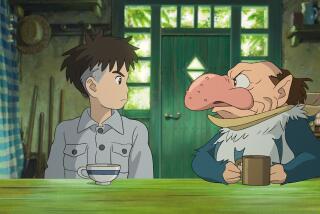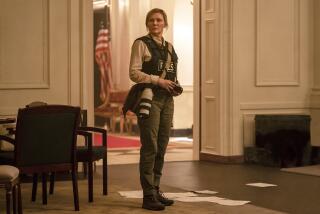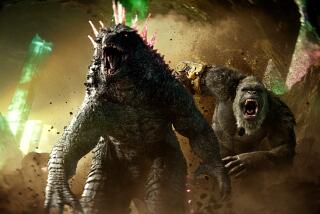How Godzilla Made His Way to the U.S.
When low-budget filmmaker Dick Kay brought a Japanese horror film called “Gojira” to the U.S. in 1956, it was simply another deal for him.
He bought the domestic rights to the film from the Tokyo-based Toho studio, rented a small sound stage on La Brea Avenue and filmed somewhat stilted English-language inserts with actor Raymond Burr--hoping to turn a profit of tens of thousands of dollars showing his dubbed black-and-white film to American audiences.
Early on in the three months or so it took to shoot and edit the American version, someone suggested Kay rename the film “Godzilla: King of the Monsters.”
“It sounded more rough, more menacing,” said Kay, 76, in a recent interview in his Beverly Hills condominium.
Total cost for the rights and the extra filming--not to mention the foam rubber Godzilla outfit that Toho shipped over from Japan--was a little less than $100,000. Hokey as it was, “Godzilla” became a horror film legend and launched scores of cheesy sequels.
Contrast that history with the estimated $175 million Sony Pictures Entertainment is spending to make and market “Godzilla,” which opened Wednesday. The studio hopes the much-hyped movie, full of computer-generated special effects, will earn hundreds of millions at the worldwide box office and become a long-running franchise for Sony.
The difference between Kay’s “Godzilla” and Sony’s version says a great deal about how the movie business has changed in the 40-plus years since the monster first hatched in the U.S. as a rubbery, fire-breathing monster bent on ravaging Tokyo.
Now retired due to health problems, Kay recalls the 1950s heyday of drive-ins and low-budget films sold to small distributors on a state-by-state basis. In contrast, Sony’s version opens on a record 7,363 screens.
In some ways, Kay’s description of what worked in the ‘50s sounds uncannily like what filmmakers still strive for today. “The trick in those days was to promise audiences something sensational: Mostly, it revolved around sex, monsters . . . oddball, weird stuff,” says Kay, whose contemporaries included Roger Corman (“Little Shop of Horrors”) and Sam Arkoff (“I Was a Teenage Werewolf”), both still-active filmmakers. “We couldn’t compete with [MGM] and the other majors; they could spend a million dollars on a picture, which was real money back then.”
Like Corman and Arkoff, Kay made a living churning out exploitation pictures. One way to save money was to buy footage from an already-produced film, trimming the need for new footage to one hour or less. In “Godzilla: King of the Monsters,” Kay deftly wove the new footage and the old to the point where a lot of people thought Burr was in the film when it was first shot.
By the time “Gojira” came along, Kay--a Wharton School of Business grad, who changed his family name from Kovnik--had already made eight or nine cheap films. These included “Untamed Woman,” which used footage from Hal Roach’s 1939 caveman film “One Million B.C.”
Kay’s partner Harry Ross (now retired in Florida) handled distribution, while Kay produced the movies. That entailed purchasing stock footage, hiring (usually young, inexperienced) directors and often helping the director to write a paper-thin script for the filmed inserts.
*
When “Gojira” was screened for Kay in Los Angeles, he quickly agreed to pay approximately $30,000 for the footage. It was almost unheard of to buy Japanese films at that time, but the picture had the right elements: big chunks of action footage and a scary monster.
Unbeknownst to Kay, rival exploitation movie maker Arkoff also bid on Godzilla through a Toho representative. “The whole situation was ridiculous,” Arkoff recalled. “We were dickering with [Toho] for about three months, then came to find the rights were already sold.”
Arkoff ended up being in business with Toho on four later “Godzilla” pictures, as it happened. These included 1964’s “Godzilla vs. Mothra” (a.k.a. “Godzilla vs. the Thing”) and 1972’s “Godzilla vs. the Smog Monster,” distributed by Arkoff’s American International Pictures.
But in 1956, “Godzilla” was all Kay’s in the U.S. He chose Burr, a minor name actor in those days, to give the movie a little marquee appeal. “You always tried to have at least a small name, to give it a little class,” Kay says.
Kay chose Terry Morse, whom he’d worked with once before, to direct the new scenes and cut them in. Shooting took a week; editing, creating advertising materials and striking prints, another 10 weeks or so.
The New York territory rights were bought by Joe Levine, an Eastern distributor who debuted the film in the summer of 1956. “I don’t know what kind of receipts he got,” Kay says, “but it must have opened pretty big, because the next day he came out on a plane and bought the rest of the East Coast from us.”
Kay says he doesn’t know exactly how much “Godzilla” ultimately grossed, because box office wasn’t carefully tracked then--and was chronically underreported by exhibitors, he adds. Also, low ticket prices and the fact that an entire carload of people could go to the drive-in for $1 made the grosses pale by today’s standards.
But “Godzilla” was clearly a financial success. Kay estimates the movie earned more than $200,000 for the distributors: himself, his partner and East Coast distributor Joe Levine. “A modest hit grossed usually $25,000 to $30,000,” Kay recalls, “so that was 8 to 10 times the amount of a modest hit.”
Kay’s company played “Godzilla” in the Western U.S., including theaters around Los Angeles. A Times reviewer wrote in July 1956: “American monsters will have to look to their laurels now that the Japanese have dredged up Godzilla. . . . If you’re a horror devotee, ‘Godzilla’ should go on your shopping list.”
Kay later sold TV rights to RKO; in 1959, the entertainment trade press reported that “Godzilla’s” television debut on L.A.’s Channel 9 (then KHJ-TV) drew nearly one out of every two TV viewers in L.A.
*
Ultimately, “Godzilla” was just a one-shot deal for Kay. Those were the days before video rights and merchandise rights became routine. “Nobody [in the business] really cared about merchandise in those days,” Kay says. (A few years later, another man, Henry Saperstein, actually licensed “Godzilla” and other cheapie movies for toys and such, and became a co-producer of several “Godzilla” movies beginning with 1965’s “Monster Zero,” according to J.D. Lees, author of the newly released “The Official Godzilla Compendium” [Random House, $16].)
Also, there wasn’t nearly as much litigation over rights; Kay says Toho played a bootlegged copy of his version successfully around Europe after it played so well in the U.S. Kay says he considered suing, but realized it would be extremely difficult, expensive and time-consuming.
The 18 sequels that followed were nabbed by deeper-pocketed distributors. Kay says he and three others with an interest in “Godzilla: King of the Monsters” were bought out by Toho for a little less than $100,000 about two years ago.
Kay says he’s not really disappointed that he’s not included in any of the current “Godzilla” hoopla. He didn’t get an invitation to the premiere, but figures he’ll get around to seeing the new film in good time.
“I don’t care. I’ve been retired nine years now,” Kay says. “Plus, the movie was strictly a job for me. It was a matter of bucks, not art.”
More to Read
The biggest entertainment stories
Get our big stories about Hollywood, film, television, music, arts, culture and more right in your inbox as soon as they publish.
You may occasionally receive promotional content from the Los Angeles Times.










